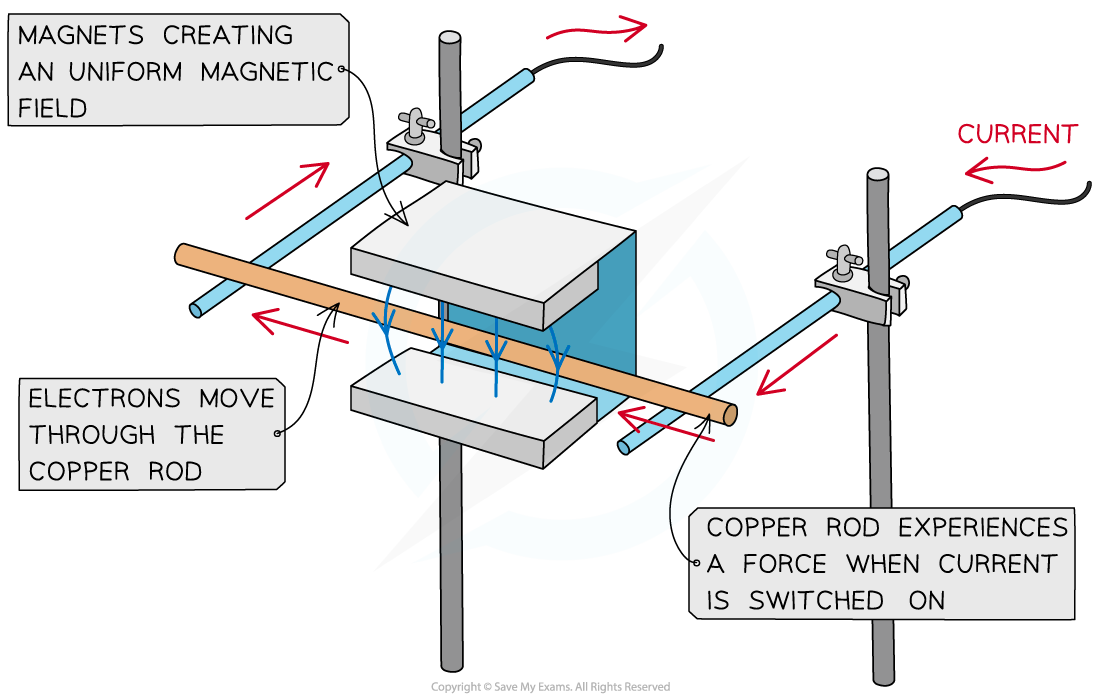Force on a Current-Carrying Conductor (Cambridge (CIE) IGCSE Physics) : Revision Note
Did this video help you?
Force on a current-carrying conductor
A current-carrying conductor produces its own magnetic field
When interacting with an external magnetic field, it therefore will experience a force
A current-carrying conductor will only experience a force if the current through it is perpendicular to the direction of the magnetic field lines
A simple situation would be a copper rod placed within a uniform magnetic field
When current is passed through the copper rod, it experiences a force which makes it move

A copper rod moves within a magnetic field when current is passed through it
Two ways to reverse the direction of the force (and therefore, the copper rod) are by:
reversing the direction of the current
reversing the direction of the magnetic field
Examiner Tips and Tricks
This phenomenon is sometimes referred to as 'the motor effect'. The direction of the force is determined by Fleming's left-hand rule.
Did this video help you?
Flemings left-hand rule
The direction of the force (aka the thrust) on a current-carrying wire depends on the direction of
the current
the magnetic field
The direction of the force (or thrust) can be worked out by using Fleming's left-hand rule:
the thumb points in the direction of the force, or thrust, on the conductor
the first finger points in the direction of the magnetic field
the second finger points in the direction of current flow (from positive to negative)

Fleming’s left-hand rule can be used to determine the directions of the force, magnetic field and current
All three will be perpendicular to each other in Fleming's left-hand rule questions
This means that sometimes the force could be into and out of the page (in 3D)
Worked Example
A current-carrying wire is placed into the magnetic field between the poles of the magnet, as shown in the diagram.

Use Fleming’s left-hand rule to show that there will be a downward force acting on the wire.
Answer:
Step 1: Determine the direction of the magnetic field
Start by pointing your First Finger in the direction of the (magnetic) Field
Step 2: Determine the direction of the current
Now rotate your hand around the first finger so that the seCond finger points in the direction of the Current
Step 3: Determine the direction of the force
The THumb will now be pointing in the direction of the THrust (the force)
Therefore, this will be the direction in which the wire will move

Examiner Tips and Tricks
Remember that the magnetic field is always in the direction from North to South and current is always in the direction of a positive terminal to a negative terminal.
Feel free to use Fleming's left hand rule in your exam, just don't make it too distracting for other students!
Did this video help you?
Charged particles in a magnetic field
Extended tier only
When a current-carrying wire is placed in a magnetic field, it will experience a force if the wire is perpendicular
This is because the magnetic field exerts a force on each individual electron flowing through the wire
Therefore, when a charged particle passes through a magnetic field, the field can exert a force on the particle, causing it to deflect
The force is always at 90 degrees to both the direction of travel and the magnetic field lines
The direction can be worked out by using Fleming's left-hand rule
In the case of an electron in a magnetic field
the second finger (current) points in the opposite direction to the direction of motion
this is because conventional current flows in the opposite direction to electron flow

When a charged particle (such as an electron) enters a magnetic field, it is deflected by the field
If the particle is travelling perpendicular to the field lines:
it will experience the maximum force
If the particle is travelling parallel to the field lines:
it will experience no force
If the particle is travelling at an angle to the field lines:
it will experience a small force
Examiner Tips and Tricks
Remember that the direction of current is the direction of positive charged. Therefore, if a particle has a negative charge (such as an electron), then the second finger (current) must point in the opposite direction to its direction of travel.
The left-hand rule can be applied to any charged particles, but in the IGCSE exam questions are likely to stick to electrons.
Did this video help you?

You've read 0 of your 5 free revision notes this week
Sign up now. It’s free!
Did this page help you?

